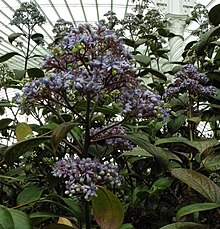Dichroa febrifuga
| Dichroa febrifuga | |
|---|---|

| |
| Scientific classification | |
| Kingdom: | Plantae |
| Clade: | Tracheophytes |
| Clade: | Angiosperms |
| Clade: | Eudicots |
| Clade: | Asterids |
| Order: | Cornales |
| Family: | Hydrangeaceae |
| Genus: | Dichroa |
| Species: | D. febrifuga
|
| Binomial name | |
| Dichroa febrifuga | |

Dichroa febrifuga (Chinese: 常山; pinyin: ) is a flowering plant in the family Hydrangeaceae. In the Indonesian language it is called gigil, alternatively tataruman in Sundanese, ramram in Papua, Hom dong (ฮอมดง) in Thai, but Yai khlang yai (ยายคลังใหญ่) in Nakhon Sri Thammarat, Yai Krang (ยายกรัง) in the South, and Hom Kham (ฮอมคำ) in Lanna (Northern Thai).
Traditional Chinese medicine
Dichroa febrifuga is an important herb in traditional Chinese medicine, where it is considered one of the 50 fundamental herbs.[2] The alkaloids febrifugine and isofebrifugine are believed to be responsible for its antimalarial effects.[3] In traditional preparations, it is used in conjunction with other plants such as Glycyrrhiza glabra (licorice), Ziziphus jujube and Zingiber officinale (ginger).[4]
References
- ^ "Dichroa febrifuga". Germplasm Resources Information Network. Agricultural Research Service, United States Department of Agriculture. Retrieved 2008-02-05.
- ^ "Dichroa febrifuga - Plants For A Future database report". Retrieved 2008-02-05.
- ^ Zhu, Shuren; Meng, Li; Zhang, Quan; Wei, Lai (2006). "Synthesis and evaluation of febrifugine analogues as potential antimalarial agents". Bioorganic & Medicinal Chemistry Letters. 16 (7): 1854–1858. doi:10.1016/j.bmcl.2006.01.009. PMC 2072810. PMID 16434194.
- ^ Rasoanaivo, Philippe; Wright, Colin W; Willcox, Merlin L; Gilbert, Ben (2011). "Whole plant extracts versus single compounds for the treatment of malaria: Synergy and positive interactions". Malaria Journal. 10 (Suppl 1): S4. doi:10.1186/1475-2875-10-S1-S4. PMC 3059462. PMID 21411015.
{{cite journal}}: CS1 maint: unflagged free DOI (link)
External links
